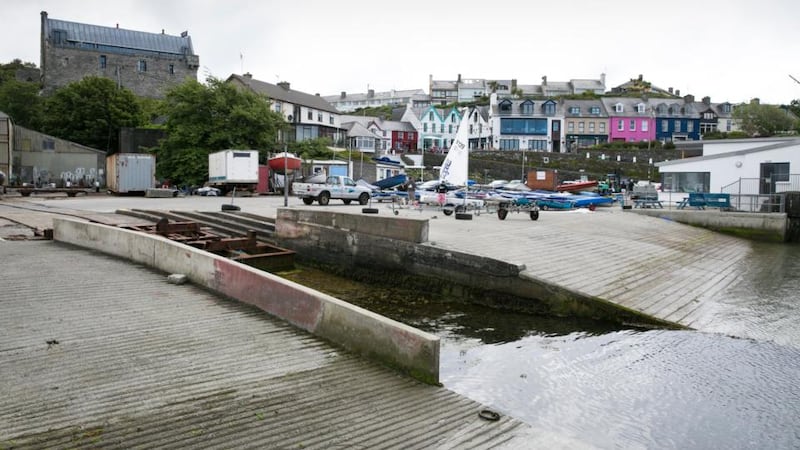There is a rumour that John Hinde photographers were issued with pots of fuschia bushes and rhododendrons that they drove around Ireland with in the boots of their cars. The reason for the botanical luggage was that, if needed, they could be strategically placed in postcard shots for a blast of colour, because in John Hinde postcards, the more colour the better.
The Hinde postcard “The Fishing Village of Baltimore, West Cork” is dominated by the red sail on the yellow dinghy at the water’s edge.
I couldn’t find out exactly when it was taken, but 1979 was mentioned a few times. Photographer D Noble took the shot: my large version (popular John Hinde cards were sometimes printed in big as well as small versions) carries the additional information that it was shot on a “4x5 Peco Junior Camera, with Ektachrome film, Symmar 180mm lens, exposure 1/125th sec”.

On the day I visit Baltimore, it is pouring; bucketing. The quayside is deserted. I orient myself near the slipway and look back at the village from D Nobel’s perspective. Unlike in the original scene, there is not a shred of blue sky to be seen.
The biggest and loveliest surprise about revisiting the scene of the postcard is that the oldest building in it has survived. Looking at the roofless stone castle at the far left of the postcard, strangled by ivy, its future seems sadly predictable. It seems like it’s going to continue to vanish, stone by stone. However, Baltimore Castle, or Dún na Séad, which dates from 1215, is not only still standing, it has been beautifully restored by Bernie and Patrick McCarthy, who bought it in 1979. Since 2005, it has been their family home. It is open to the public and has a pirate-themed exhibition and an extraordinary barrel-vaulted banqueting hall that overlooks the sea. Patrick says that it was always privately owned. Photographs on the walls document the vast restoration project.
Bernie’s great-aunt once owned the building that is now the Waterfront Hotel, owned by the Jacobs family. In the postcard it is to the left of the barrel-topped white building.
As we’re talking, I can hear odd sounds nearby that are familiar and yet very strange. I hear words, but they’re gibberish. “Bye bye.” “Throw the ball.” “Cheese.” It’s Shakespeare, their African grey parrot. Baltimore is well known for pirates, after all, so the presence of a parrot should be less unexpected and entertaining than it is (I can’t stop laughing). “Shakespeare has so many words, we’re waiting for him to write a sonnet,” says Bernie.
The dominating boat
The boat that dominates the centre of the postcard was called The Richard. It was owned by Dermot Kennedy, who lives in the last house to the right of the postcard and who established Glenans sailing school.
The boat, which he bought in the late 1960s, was getting a new keel put on it at the time. The Richard was the "last sailing boat, with an auxiliary motor built into it, that was built by Paddy Hegarty's boat yard in Baltimore". The boatyard is still there, now run by Paddy's sons Liam and John.
Kennedy identifies the man on the ladder at the boat's keel as Steve Nolan, from Sherkin Island. "A great man for the yoga," he adds, which seems a random pastime for an Irish boat-tending islandman in the 1970s. As random as a parrot in a 13th-century castle asking for cheese. Kennedy sailed The Richard "all over the north African coast and to the Mediterranean, and to the Skelligs for birdwatching".
So where is The Richard now? "Wrecked," Kennedy says sadly. "I sold it in the early 1980s. It was sailed across the Altantic and, on the way back, it hit a storm. I think it was towed to the Azores."
The yellow couple
He is not sure who the yellow couple are. “Were they Hopkins? From Cork? I don’t know.”
“I think they were a couple from Cape Clear,” says Dominic Casey, of Casey’s Hotel in the village.
Aidan Bushe at what is now Bushe’s Bar on the quay laughs when I tell him this. “They don’t look like Capers to me,” he says, using the local lingo for people from Cape Clear, as he indicates the mustard trousers. “I’d say they were tourists.”
Bushe says that the housing scheme, Cliff Estate, now visible on the hill behind the quay-front buildings, was built a few years after the picture was taken.
The distinctive barrel-topped white building in the postcard was a chandlery at the time, and also sold coal, gas and cement. It was called Cotters then. Kieran Fuller – himself originally a Caper – bought it in 1977. “It only had an old roof on it, like you’d see on cowsheds; a corrugated iron roof.”
They ran it as a chandlery until 1981, and then knocked it down and rebuilt it. “We put in a grocery shop and some hardware and chandlery on the first floor, and the rest of the first and second floor became accommodation.” That was also the year he got married, and they moved in the following year. They still live there.
“The first thing I do every morning is to head to the window and see what’s happening in the world,” he says.
- Series concluded








